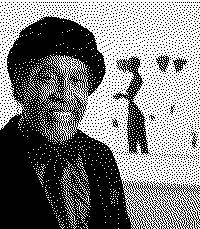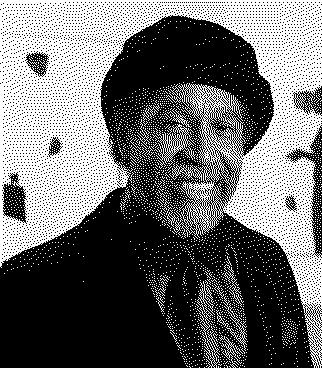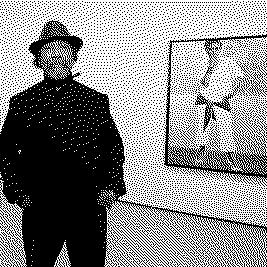Artists/Barkley Hendricks
Fast Facts
Portraiture and Figurative Painting
Hendricks was renowned for his life-sized portraits, predominantly of African Americans. His work is celebrated for its portrayal of black Americans with a new and profound depth, dignity, and sophistication.
Influence from Photography
His compositions were often influenced by photography, featuring subjects posed against monochromatic or minimally detailed backgrounds, giving his paintings a striking, almost photographic quality.
Social and Cultural Commentary
His work often contained social and cultural commentary, particularly regarding race, gender, and sexuality. Hendricks played a crucial role in challenging the norms of traditional portraiture and the representation of black figures in art.
Education and Teaching
Hendricks held a Bachelor of Fine Arts and a Master of Fine Arts from Yale University. He was also an influential professor at Connecticut College from 1972 until his retirement in 2010.
Biography



Barkley L. Hendricks, born on April 16, 1945, in Philadelphia, Pennsylvania, was a trailblazing American artist known for his impactful portrait paintings of ordinary Black men and women, presented with the grandeur and scale reminiscent of Old Master paintings.
His innovative and bold works, although inspired by popular culture, music, and sports, were deeply personal rather than overtly political. Hendricks expressed that his paintings were about people who were part of his life, offering a glimpse into the personal connection he felt to his subjects.
Growing up in Philadelphia, Hendricks was raised in a household where his father worked in construction and his mother was a homemaker before becoming a teacher's aide. He was one of five children, and after graduating from Simon Gratz High School, he pursued his passion for art at the Pennsylvania Academy of the Fine Arts. It was during his studies here that Hendricks embarked on a life-changing trip to Europe, where he visited numerous museums and was both enchanted by the beauty of the portraits he saw and dismayed by the lack of Black representation. This experience motivated him to fill that void in the art world.
After completing his certificate at the Academy of the Fine Arts in 1967, Hendricks enlisted in the New Jersey National Guard and began working as an art teacher. His early career also saw him exploring the aesthetics of basketball through painting, an interest that stemmed from his love for the sport. Hendricks furthered his education and skills at Yale University, where he earned both bachelor's and master's degrees in fine arts within two years. He later taught at Connecticut College until his retirement in 2010.
Hendricks's work, particularly during the Black Power movement, was often scrutinized for political messages, even though he maintained that his focus was on portraying the individuals in his life. His famous piece "Lawdy Mama" (1969), for instance, features a subject with an Afro hairstyle reminiscent of Angela Davis, yet Hendricks insisted the painting was of someone from his personal circle.
Notably, Hendricks's paintings such as "Icon for My Man Superman" (1969) and "Brilliantly Endowed" (Self-portrait, 1977) have been especially influential, inspiring tributes from artists like Fahamu Pecou and Rashid Johnson. During the 1980s, specifically the Reagan era, Hendricks took a hiatus from portrait painting to focus on landscapes and photography, only to return with renewed vigor to portraiture in the last fifteen years of his life, showcasing his versatility and depth as an artist.
Hendricks's legacy is vast, including the significant impact of his first career retrospective, "Barkley L. Hendricks: Birth of the Cool," which highlighted his contributions to art from 1964 to 2008. His work continues to inspire, as seen in exhibitions and tributes that celebrate his influence on contemporary portraiture and the representation of Black figures in art.
Hendricks's contributions to art were recognized up until his death on April 18, 2017, in New London, Connecticut, leaving behind a rich legacy that continues to influence and inspire. His life and work exemplify a commitment to depicting the reality and beauty of Black lives, making a lasting impact on the art world (Wikipedia) (Encyclopedia Britannica).
Importance
Barkley Hendricks' importance in the art world can be summarized across several dimensions, reflecting his profound influence and the significant impact he made:
Revolutionizing Black Portraiture
Hendricks is celebrated for his pioneering contributions to Black portraiture, capturing the lives of ordinary Black men and women with the grandeur and depth typically reserved for works of the Old Masters. His paintings are marked by their bold, experimental style, challenging the norms and expanding the representation of Black individuals in art. His work not only honored the individuality and dignity of his subjects but also contributed significantly to the discourse around identity, representation, and racial politics in art (Encyclopedia Britannica) (The Frick Collection).
Engaging with European Art Traditions
Hendricks' exposure to European art during his travels profoundly influenced his approach to portraiture, blending the techniques and sensibilities of European Old Masters with the vibrant culture and aesthetic of the African American community. This unique fusion allowed Hendricks to create works that were both reflective of his personal experiences and resonant with broader historical and cultural narratives (Encyclopedia Britannica).
Influence on Contemporary Art and Artists
Hendricks' work has left a lasting legacy on contemporary art, influencing a wide range of artists across generations. His innovative approach to portraiture, utilization of color, and exploration of identity have been inspirational for many, including prominent artists like Kehinde Wiley and Rashid Johnson. The "Barkley L. Hendricks: Portraits at the Frick" exhibition and the accompanying catalogue featuring contributions from artists and creatives highlight the breadth and depth of his impact (Art & Object) (The Frick Collection).
Commercial Success and Recognition
The commercial success of Hendricks' work, such as the record-setting sale of his painting "Yocks" in 2019 for $3.72 million, underscores the growing appreciation and demand for his art. This recognition is a testament to his talent and the increasing acknowledgment of the value of representations of Black lives and experiences in the fine art market (Wikipedia).
Diverse Artistic Output
In addition to his iconic portraits, Hendricks' oeuvre includes landscape paintings, photography, and works on paper, showcasing his versatility and breadth as an artist. His ability to work across different mediums and genres further emphasizes his creative genius and technical skill (Barkley L. Hendricks).
Technique
Barkley Hendricks' painting technique and artistic approach are as distinctive as his subjects, making a profound impact on the world of art through several key elements:
Life-Size Portraits with Monochromatic Backdrops
Hendricks is renowned for his life-size oil portraits of Black Americans, often set against monochromatic backdrops. This technique emphasizes the self-assurance and stylish confidence of his subjects, allowing their personalities and fashion to take center stage. His approach to portraiture, capturing individuals in contemporary settings with a strong sense of personal style, was groundbreaking (Wikipedia) (www.wikiart.org).
Influence from European Masters and Popular Culture
His work is a blend of inspirations from European Old Masters and the vibrancy of contemporary African American culture. Hendricks' exposure to European art during his travels influenced his approach to portraiture, combining traditional techniques with modern, culturally relevant themes. This fusion is evident in his meticulous attention to detail, composition, and the vibrant depiction of his subjects (Encyclopedia Britannica).
Photography and Manipulation of Framing
Hendricks' interest in photography, particularly during a period when he focused on this medium exclusively, further influenced his approach to framing and composition in his paintings. He had a knack for capturing realness and the oddness of everyday encounters, often employing unusual angles and perspectives. This photographic sensibility is evident in his painted works, where the framing and composition invite viewers to see his subjects in a dynamic, multidimensional context (Musée Magazine).
Utilization of Reflective Surfaces and Self-Portraiture
Hendricks occasionally used reflective surfaces to add depth and complexity to his compositions. In one notable example, he painted a portrait where only the reflection of the subject is visible, a technique that challenges viewers to consider the relationship between the artist, the subject, and the viewer themselves. This method showcases Hendricks' ability to engage with his subjects and their environments in a manner that is both intimate and introspective (Musée Magazine).




